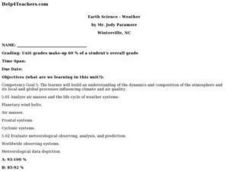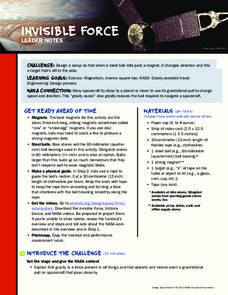Curated OER
Lesson Plan on Kepler's Laws of Planetary Motion
Learners construct a solar system model. For this space science lesson, students calculate the eccentricity of a planet's orbit. They calculate the period of a planet's revolution using Kepler's formula.
Curated OER
Astonishing Planetary Discovery
Students access the Internet, research one of the planets, copy and paste necessary information, and design a creature that would survive for a year on their planet. They present their creature and its qualities to the rest of the class.
Curated OER
Planetary Problem Solving
Students create their own planet. They determine its diameter, density, composition, mass and orbit. Students create a list of elements necessary to sustain human life. They present their model to the class.
Curated OER
Earth Science - Weather
Students build an understanding of the dynamics and composition of the atmosphere and its local and global processes influencing climate and air quality. They analyze air masses and the life cycle of weather systems.
Alabama Learning Exchange
Planetary Cereal Project
Sixth graders decorate an empty cereal box with information and games showing their comprehension of factual information about an assigned planet. This is a nice, creative lesson about the solar system.
Illustrative Mathematics
Solar Eclipse
Learners take on the role of astronomers, calculating conditions necessary for a total solar eclipse. Concepts of similar triangles and properties of circles come together as pupils create ratios and use real measurements in determining...
Curated OER
Astronomical Data
In this astronomy learning exercise, students use a chart with planetary data comparing the inner planets to each other. Students will use the period of rotation, period of revolution, and distance from the sun for these inner planets to...
Virginia Department of Education
Historical Models of Atoms
What does the past have to do with today? Young scientists find that answer as they learn more about past chemists and their significant contributions to the field. Pupils use the Internet to research historical figures...
Curated OER
Good Vibrations Remote Sensing data Collection: Thermal Emission Spectrometer
The Mars Global Surveyor spent two years creating a mineral map of the planet Mars using thermal emission spectrometry. To help young astronomers understand this remote sensing instrument, have them simulate how data is collected and...
Virginia Department of Education
Planet Line-Ups
Should Pluto be considered a planet or a dwarf planet? Scholars research planets in our solar system to understand their similarities and differences. It also includes memory activities related to the order of the planets.
Curated OER
The Great Planetary Debate
Students' are given a research sheet to complete in small groups. They are to select a planet or moon to research using the Internet. With this research and their completed form, each group defends their planet or moon in a debate...
Curated OER
Universal Gravitation and Kepler's Laws
Students develop problem-solving strategies dealing with Kepler's laws of planetary motion. they examine the law of universal gravitation and continue with problem-solving strategies. Students complete a take-home quiz.
American Association for the Advancement of Science
Sensing the Invisible: The Herschel Experiment
Learners of light will construct a contraption in which light is passed through a prism and shone into a box. The temperatures at different points along the path and outside of the path of light. The intent is to imitate William...
TED-Ed
Tycho Brahe, the Scandalous Astronomer
Who says scientists are boring geeks? Certainly not the narrator of a short video who dishes up the scandals associated with Tycho Brahe, a Danish scientist and alchemist (now that's two labels you don't often see together) who used...
University of Colorado
Distance = Rate x Time
Every year, the moon moves 3.8 cm farther from Earth. In the 11th part of 22, classes use the distance formula. They determine the distance to the moon based upon given data and then graph Galileo spacecraft data to determine its movement.
PBS
Invisible Force
Investigate invisible forces. Young engineers design a setup that changes the direction of a steel ball using a magnetic force. The purpose of the setup is to model the gravitational pull of spacecraft by planetary bodies.
Curated OER
Motion Through the Ages
Eighth graders conduct internet research to produce a timeline of man's growth in understanding of concepts of motion and planetary motion through history.
Curated OER
Calculating Orbital Speeds
Students are introduced to the regularities of planetary motion. They create a spreadsheet to calculate the speed of any orbiting body at apogee and perigee. Students then use the spreadsheet to compare the speeds of planets, moons,...
Curated OER
Investigating the Biosphere with Planetary Models
Students model the biosphere and manipulate variables affecting change and plan their experiments with the help of others. They describe their question, hypothesis, and methods of investigation.
Curated OER
Planetary Weather
Students are asked what do they recall about weather. They reasearch weather on the other planets of the solar system. Students work in groups and each group is assigned two planets. They create a display showing the weather on each...
Curated OER
Introduction to the Planets
Young scholars become familiar with the members of the solar system and planetary order. They identify differences and characteristics of individual planets. Finally students visualize the great size of the solar system and make the...
Curated OER
The Toilet Paper Solar System
Students classify the planets in the solar system, study planetary objects, and measure the relative distance between planets. In this solar system lesson, students use toilet paper to complete a scale model of the distance between the...
Curated OER
Earth, Moon, Mars Balloons
Students demonstrate size and orbits of Earth, Moon, and Mars. In this space science lesson plan, students will use balloons to show how the size and distance between the planets and satellite compare.
Curated OER
PLANETS IN PROPORTION
Students discover scales for both the solar bodies' relative sizes and their distances from the sun. They find equatorial circumference and volumes of their solar bodies. Students apply estimation strategies and proportioanl reasoning to...























